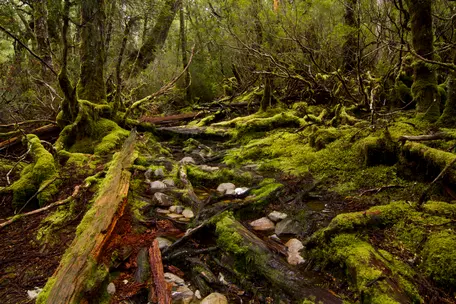Using a Paleoecology Approach to Study Human-set Fires in New Zealand

Jump down to: Key Research Questions | Learn More | Related Links
Why study human-fire interactions in New Zealand?
New Zealand provides a unique setting for examining human impacts because the country was settled fairly recently (c. 700 yrs ago) during a time of relatively stable climate. In addition, the temperate forests of New Zealand were sensitive to land-use activities that accompanied human arrival. The first peoples in New Zealand initiated a sequence of events that resulted in the loss of more than 40 percent of the forests, and this deforestation occurred within decades of human arrival. It was accomplished by the introduction of a new disturbance—fire. Additionally, these widespread forest transitions were initiated by relatively small, mobile populations in the absence of climate change, a situation that is contrary to other temperate forest regions where deforestation was associated with dense agricultural populations and/or significant climate change. New Zealand offers one of the most dramatic examples of human-caused deforestation through the deliberate use of fire, and its vegetation and fire history provides an important case study for understanding the consequences of temperate forest transitions occurring worldwide today.
Key research questions
The following are key research questions related to the study of human-fire-climate interactions in New Zealand:
- How did fire activity change after humans arrived?
- Were the environmental consequences of human-set fires a result of the frequency and type of fires or by environmental conditions (e.g. rainfall, temperature ?
- Why did native beech forests fail to recover following decreases in fire activity?
- How can New Zealand example help us better understand temperate forest vulnerability to future climate warming and land-use change?
- How did early humans shape fire and what were the ecological consequences?
- Why are some ecosystems more sensitive to human activities, particularly human-set fires, than others?
- How can we use what we learn from investigating past and present human influences to support ecosystem resilience to changing climate conditions?
On a global basis, real-world applications of answering these and other related research questions include:
- Help managers anticipate vulnerabilities and impacts of future land-use and climate change.
- Prioritize conservation efforts globally, particularly in identifying regions that are largely pristine and worthy of protection.
- Lay the groundwork for developing restoration and management objectives that help support ecosystem resilience to changing conditions.
Learn More
Scientists working on this project outline a conceptual model for understanding human impacts on fire regimes and vegetation in different settings
Results documenting early human and European impacts in New Zealand are found in two papers
- Rapid landscape transformation in New Zealand
- Changes in Fire Activity following human arrival in New Zealand
This article in Te Ara - The Encyclopedia of New Zealand tells the story of human effects on the environment in New Zealand, beginning with the earliest humans.

Related links



![[creative commons]](/images/creativecommons_16.png)